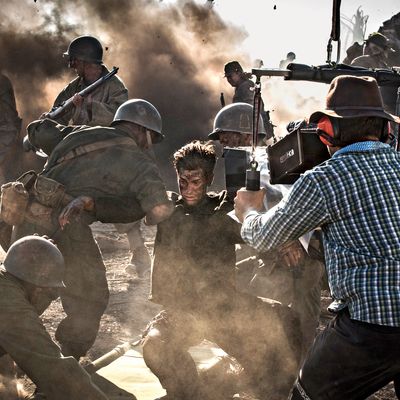
Director Mel Gibson’s Hacksaw Ridge is notable for two reasons: One, because it tells the true story of Desmond Doss (Andrew Garfield), a World War II medic and Seventh-day Adventist who, despite refusing to touch a weapon because of his pacifist beliefs, saved scores of his comrades and won the Medal of Honor. And two, because it’s arguably Gibson’s most graphically gory movie — no small feat from the director of Braveheart, Apocalypto, and The Passion of the Christ. We asked Gibson about his approach to orchestrating carnage and where, or if, he draws the line.
Establish the horror.
After Doss and his unit scale a ridge, they come upon a field full of body parts and corpses, some with intestines hanging out, others being eaten by rats. Then the bullets and explosives start flying. “You want to wreak havoc with a lot of blood to emphasize the courage of the character,” says Gibson. “The level of the carnage involved is necessary to tell a story about the hell a man can go into. There’s stuff I saw in real war footage that shocked me. When people get hit by 30-caliber machine-gun fire, they get chopped to pieces.”
But keep it clear.
“When you’re filming a battle sequence, you have to imagine it visually and be very clear about what’s going on,” he says. “There’s ordered chaos, so you have to be very mindful about how you show it, about clarity of action: who is who, who’s doing what to whom, why it happens.”
Embrace your inner animal.
In a harrowing scene, a soldier picks up a corpse and uses it as a shield while charging the enemy line. “He’s doing something pretty animal. I thought, What would I do if I was trying to avoid being hit by a rain of bullets? I’d find some cover and see if I could move with it.”
But know when to hold back.
The real Doss suffered serious injuries, but Gibson declined to show the most gruesome of them in favor of going for a more emotional impact. “There is a place I won’t go. I’ll go reasonably far, but I gauge myself — because you don’t want people running out screaming.”
*This article appears in the October 31, 2016, issue of New York Magazine.

